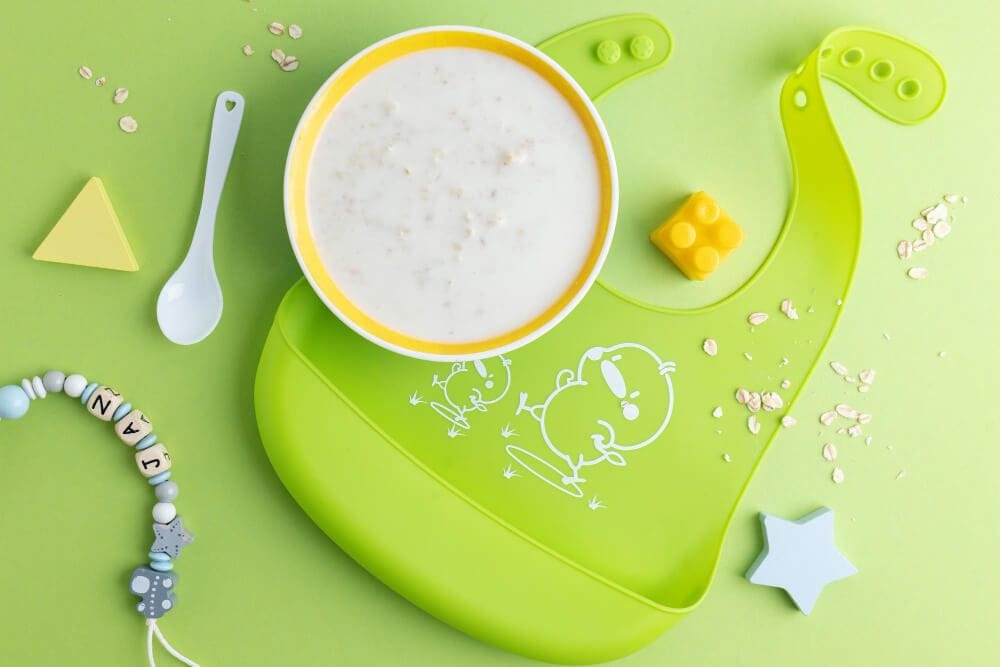Your baby's first step toward eating solids is an exciting milestone. The first step in discovering and exploring a broad range of flavors is, to start eating solids. Before your infant takes that first bite, you should be aware of the following.
- What is the Importance of Solids for Baby?
As babies grow, they require solid foods to provide the nutrients necessary for their development and growth. Iron, zinc, and other minerals are among these necessary nutrients. Babies use the iron that was accumulated in their bodies throughout the first six months. Additionally, breastfeeding or infant formula provides them with some iron. However, as babies age, their iron reserves decrease. Babies should begin eating solid food at the six-month mark.
The introduction of solids is crucial for assisting infants in learning to eat by exposing them to a variety of
different flavors and sensations. Their teeth and jaws grow, and other skills are developed that will be
necessary for language development later.
- Is Your Baby Ready for Solid Foods?
From birth to 6 months old, breastfeeding, formula, or a combination of both can fulfill all the nutrient requirements of a baby. Although they can start solid foods between 4 and 6 months, it really depends on your baby. While some infants may be perfectly fine to wait longer, others could be eager to begin eating.
Why starting solids too early isn’t a smart idea?
1) Very young baby’s digestive system is not fully developed to digest solids
2) Baby’s digestive system have lack some important digestive enzymes for the breakdown of solids.
3) Young babies involuntarily rejects any foreign thing placed in their mouth
4) Can lead to obesity and improper eating habits in future
5) if you're breastfeeding, feeding only breast milk up to around 6 months of age will help protect your baby from illness and infections
When to start introducing solid foods?
In addition to age, you should consider a few signs that your little one is ready to have baby foods.
1) Baby should be able to sit upright and hold up head and neck straight when providing a support
2) They show an interest in food – for example, they look at what’s on your plate
3) Babies opens their mouth when you offer them food on a spoon
4) They should be able to swallow the food.
If your baby does not seem ready to eat yet, it’s extremely ok. In fact, it's typically better to wait than to start early (before 4 months). Most babies are ready to start solids between 5 and 6 months.
What are the Tools that You Need?
- Feeding Chair
Your infant must be safely seated in an upright position (so they can swallow properly). In a high chair, a safety belt that is properly fitted is a must. Never leave infants alone on elevated surfaces.

2. Plastic or pelican bibs
This will help keep clean your baby’s cloths from falling food pieces

3. Weaning spoon
Soft weaning spoons are suitable. These spoons are safe for your baby’s gum.
4. Small plastic bowl or plate
Now your little one has a new plate or bowl for him! This will increase your baby’s excitement about eating
5. First cup
Introducing water is also important when you introduce solids. If you introduce an open cup or a free-flow cup without a valve, your infant will learn to sip, which is also healthier for their teeth.
6. Mat
To capture the majority of the mess, place a dirty mat or newspaper sheets under the feeding chair. This will ease the cleaning of the feeding area.
Hygiene First!
It's crucial to take extra precautions to avoid endangering your kid when you first introduce them to solid foods. So your sanitary level, while feeding must be in a higher place. Here are some Key food safety and hygiene tips.
1. Always wash your hands before preparing food and feeding your baby while keeping surfaces clean.
2. Wash your baby’s plate, spoon, and even their hands before they touch the foods
3. Clean the feeding area before and after feeding
4. Use a bib to protect baby’s clothes from dirt
5. Clean and sterilize the tools, that you use for preparing and feeding meals
6. Properly wash fruits and vegetables before preparing. Make sure dirt completely wash off the surfaces
7. Keep cooled, boiled water in a container with the proper lid for the baby’s use
What is the Best Place and Time for Weaning?
The dining room is the best place to start feeding as he or she can eat with family members and learn good eating habits from the family. Also they can experience family time. Make sure select the calm and clean environment without digital screens like phones, tablets and even the television.

The best time for first feed is when baby and you are both happy and relaxed. So first of all give them their favorite breast milk or formula first. Then you can introduce the new taste to your little champ with no worries as he satisfied with milk already.
How long and How much?
Start with just a teaspoonful or two. This allows your baby to learn how to swallow solids. Start with one meal per day, then increase it to two (likely a breakfast and an evening meal) for the next month or so.
Take plenty of time, especially at first. But stopped when you notice that your baby is no longer interested. Don’t forcefully feed them. Here are some signs to decide that your baby is full;
1. Turning their head away
2. Getting distracted
3. Pushing the spoon away
4. Clamping their mouth shut
What to give First?

Start with single-ingredient food with no salt and sugar. Choose a single-grain, iron-enriched, whole-grain variety like brown rice, whole-grain oat, or whole-grain barley. Mix a small amount of baby cereal with formula or breast milk to give them a familiar taste. Foods should be soft or pureed to prevent choking. Gradually, you can introduce different types of foods to your baby’s meal while carefully observing for food allergies (which will discuss in another article).
Safety Tips
1. Always stay with your baby when they're eating as they can start to choke or even they can fall from the chair.
2. Remove seeds from fruits and bones from meat or fish.
3. Test the cool and hot foods before giving the baby
4. Avoid hard foods like whole nuts, raw carrot,s or apple
5. Cut small, round foods, like grapes and cherry tomatoes, into small pieces
Final Message
Even if they don't seem to enjoy some of the items you're offering, be patient and keep trying. Your baby may need at least ten or more attempts to get acclimated to new tastes, textures, and meals. There will be days when they eat more, days when they eat less, and days when they refuse everything. This is entirely normal, so don't worry. Turn the feeding time into a fun time!

